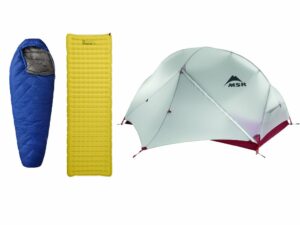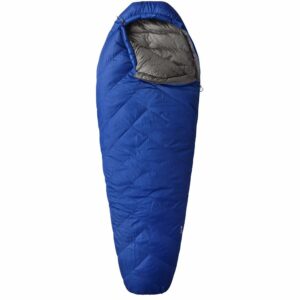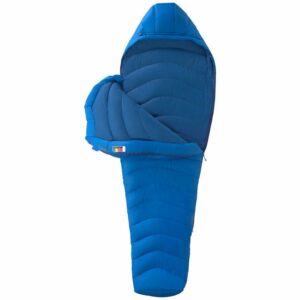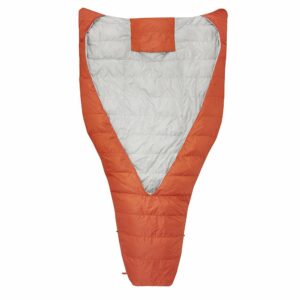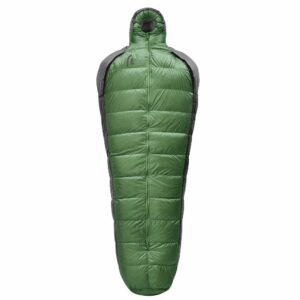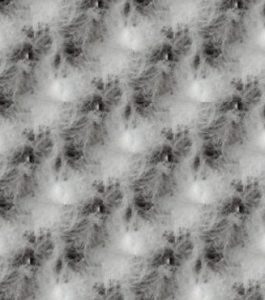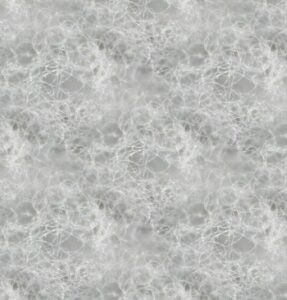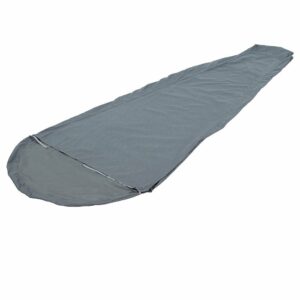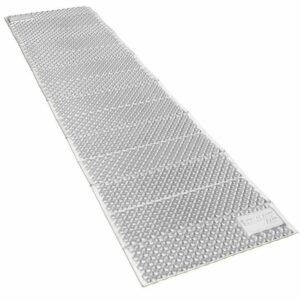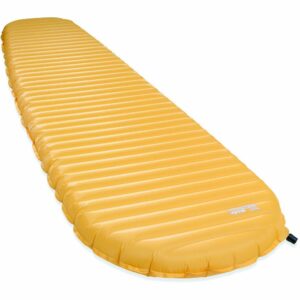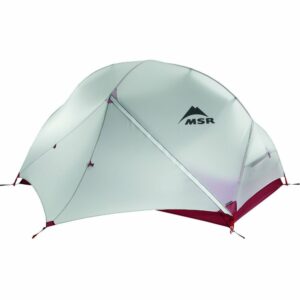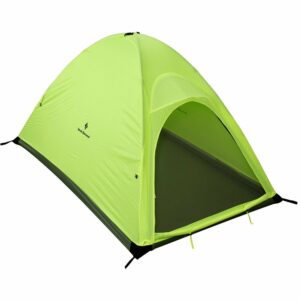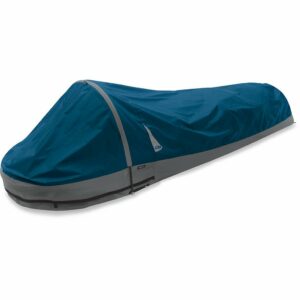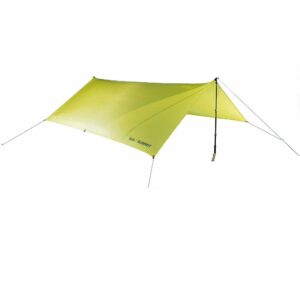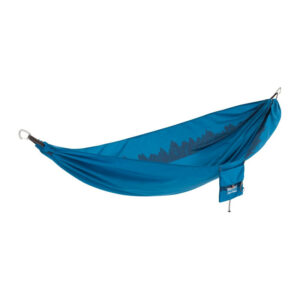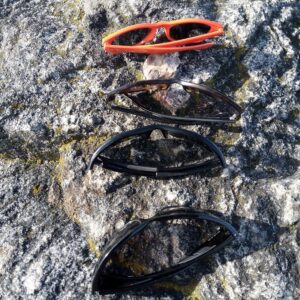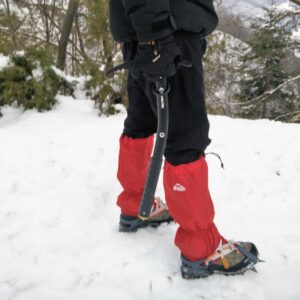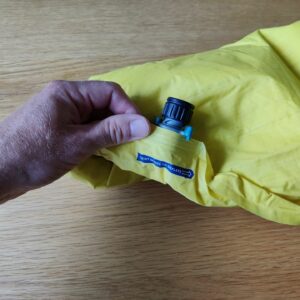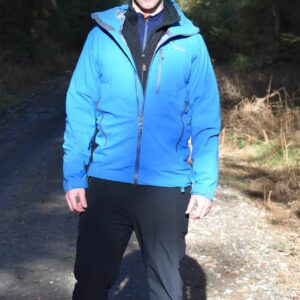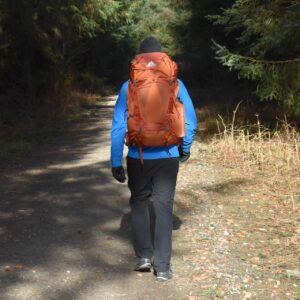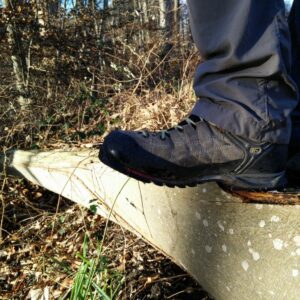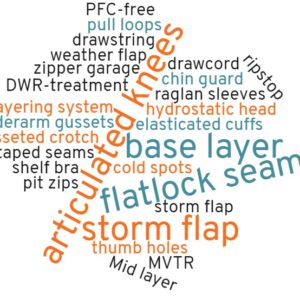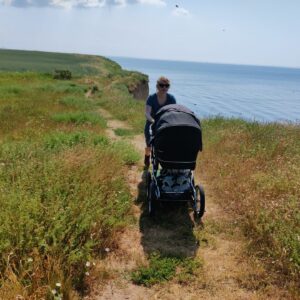Multi-day hikes usually require sleeping equipment so that you can stay comfortable and warm during the nights in the outdoors. Many of those who are new to hiking are in doubt what sleeping equipment to use on their trips. Therefore, we made this hiking sleeping equipment guide which explains the qualities and characteristics of different sleeping gear items for comfortably spending the nights in the outdoors.
The basic trio of sleeping equipment for hiking includes a sleeping bag, a sleeping pad and a portable shelter of choice. However, not all three items are required for every overnight trip. In very warm and dry weather you might not need a shelter (depends on insects in the area and your comfort preferences) and if you are staying in a mountain shelter or similar you will usually only need a sleeping bag. Items for additional comfort include pillows and sleeping bag liners (see more below). Sleeping bags, sleeping pads and portable shelters are typically designed for specific environment (temperature, humidity etc.) and thus they should be selected according to the expected conditions on the trail; double wall tents, for example, are great for 3-season hiking but perform poorly in harsh winter conditions.
Jump to:
Sleeping Bags
Primary function: Reduce convective heat loss
A sleeping bag reduces the convective heat loss by trapping body-warmed air within its insulation layer. The insulation layer consists either of down or synthetic fill and is sandwiched between two layers of fabric (shell fabric on the outside and lining on the inside). Sleeping bags don’t provide good protection against the elements (snow, rain, wind etc.) as they have to be breathable to prevent condensation from building up on the inside. They are one of the heaviest and most space-consuming pieces of hiking equipment and thus it’s very important to have a sleeping bag which offers a good warmth-to-weight ratio and compresses well. A sleeping bag should always be selected according to the expected temperatures because this allows you to pack efficiently – it doesn’t make sense to use a winter sleeping bag at warmer temperatures because winter sleeping bags are typically heavier and larger than less-insulated sleeping bags. Sleeping bags differ by style, materials, temperature ratings, size and features.
Sleeping Bag Styles
The most common styles of sleeping bags are mummy, quilt and wearable.
Mummy Sleeping Bags
Mummy sleeping bags are the most common type of sleeping bags. They snugly enclose your body and head for good insulation. Typically they have a zipper on the side which allows you to easily get in and out of the sleeping bag. Most mummy sleeping bags are gender-specific; women’s models are usually more insulated and have a slightly different shape and size. Mummy sleeping bags offer better insulation than quilts due to the snug fit they offer (the body-warmed air can’t escape to the outside). Nevertheless they are heavier than quilts as they require more insulation/fabric.
Pros:
- Warmer than quilts
- Snug fit
Cons:
- Weight
More about mummy sleeping bags:
Quilts
A quilt doesn’t snugly enclose your body like a mummy sleeping bag. Instead it leaves your back in direct contact with the sleeping pad. However, quilts are typically large enough to be partially tucked under your body. Quilts are becoming increasingly popular for lightweight hiking and backpacking because they are lighter than mummy sleeping bags. It has also been claimed that mummy sleeping bags in fact aren’t much warmer than quilts because the insulation on the underside of such a sleeping bag anyway gets smashed by your body weight and thus cannot efficiently trap the body-warmed air. Nevertheless, during the night it’s hard to keep a quilt snugly around your body and thus a certain percentage of body-warmed air escapes to the outside. Some high-quality quilts, such as the Katabatic Gear Palisade, feature a footbox for better insulation in the feet area and straps so that it can be attached to a sleeping pad. Generally speaking, quilts are a great option for 3-season lightweight hiking while winter hiking requires a mummy sleeping bag designed for low temperatures.
Pros:
- Lighter than mummy sleeping bags
Cons:
- Hard to keep snugly around your body
More about quilts:
Wearable Sleeping Bags
Wearable sleeping bags are typically mummy sleeping bags which allow you to put your hands and legs out through zippered or non-zippered openings. These openings to some extent decrease the thermal efficiency of the sleeping bag but on the other hand such sleeping bag can be used for around-the-camp activities and during rest stops. An example of such sleeping bag is the Sierra Designs Mobile Mummy.
Pros:
- Can be used for around-the-camp activities
Cons:
- Less thermally efficient than a mummy sleeping bag
Sleeping Bags Materials
Sleeping bags consist of lining, shell and an insulation layer.
The lining and shell are typically made of nylon because nylon provides good durability and absorbs very little moisture (rain, sweat etc.). The shell is sometimes treated with DWR (Durable Water Repellant) to further increase the weather protection (DWR treated fabrics repel the water).
Insulation is the most vital feature of any sleeping bag as it determines how thermally efficient it will be in relation to its weight (warmth-to-weight ratio). Sleeping bags typically use either down or synthetic fill for insulation.
Down Insulation:
Down is one of the best insulating materials available and thus down sleeping bags offer better weight-to-warmth ratios than sleeping bags with synthetic insulation. Furthermore, down sleeping bags compress better and thus they take up less space in your backpack. However, they also have disadvantages; they are pricey and often unable to offer good insulation when exposed to moisture (rain, humidity etc.). To mitigate the latter, manufacturers often treat down insulation with DWR (Durable Water Repellant) so that it retains better warmth when exposed to moisture. Such down is often referred to as hydrophobic down (like for example Mountain Hardwear’s Q.Shield hydrophobic down). It should be noted, however, that even DWR treated down looses up to 30% of its warmth when moist/wet. Down sleeping bags are thus best for relatively dry environments.
The quality of down insulation is measured by the fill-power index – the higher it is, the better loft (and thus warmth) the insulation offers. The fill-power of down insulation varies from 400 (low grade) to 900 (high grade).
Pros:
- Warmth-to-weight ratio
- Compressibility
Cons:
- Pricey
- Reduced insulation when exposed to moisture
Synthetic Fill:
Sleeping bags with synthetic insulation have inferior warmth-to-weight ratio in comparison to down sleeping bags, but on the other hand they are less expensive and offer good warmth even when exposed to moisture. Synthetic insulation is typically made of polyester fibers which are structured to mimic the structure of down clusters. Nevertheless, even the most sophisticated synthetic insulation is in dry conditions only as efficient as 600-fill-power (medium grade) goose down. High-quality synthetic insulations include PrimaLoft, G-Loft and Mountain Hardwear’s Thermal.Q. Sleeping bags with synthetic insulation are best for humid conditions.
Pros:
- Inexpensive
- Good warmth even when exposed to moisture
Cons:
- Warmth-to-weight ratio
- Compressibility
Sleeping Bags Temperature Rating
The temperature rating of a sleeping bag is typically listed by the EN 13537 standard which includes four different ratings; extreme temperature, lower limit, comfort temperature and maximum temperature.
- Extreme Temperature: Temperature at which an average woman will survive with the possibility of suffering hypothermia
- Lower Limit: Temperature at which an average adult male will be comfortable
- Comfort Temperature: Temperature at which an average woman will stay comfortable
- Maximum Temperature: Temperature at which the sleeping bag would cause overheating
Please note that not all manufacturers use the EN 13537 standard to determine these ratings and thus it’s vital to check that the ratings for a sleeping bag are based on the EN 13537 standard. Also keep in mind that these ratings do not apply perfectly to everyone (some get cold faster than others) and thus it’s important to figure out how these ratings apply to you specifically by testing the sleeping bag before doing a long trip far away from civilization.
Sleeping Bags Size
Sleeping bags typically come in two sizes (regular and long). You should always select the size that fits your body. If a sleeping bag is too short, you will have problems sleeping comfortably and if a sleeping bag is too long it won’t provide the optimal insulation.
Sleeping Bag Liners
A sleeping bag liner (very thin sleeping bag that goes inside a real sleeping bag) keeps your sleeping bag free of dirt and body oils. It also adds some extra warmth, depending on the material out of which it is made (typically cotton, silk, fleece or nylon shell + synthetic insulation). However, liners add very little extra warmth to the sleeping bags as they have to be very thin to fit in. Therefore, they are primarily used for comfort and keeping the sleeping bag clean and free of body oils. Body oils can decrease the sleeping bag’s thermal efficiency to some extent – this is especially true for down sleeping bags. A sleeping bag liner is not a necessity; whether you choose to use one or not depends more or less on your preferences (comfort, washing etc.).
Sleeping Pads
Primary function: Reduce the heat transfer to the cold ground
A sleeping pad reduces the heat transfer between the sleeping bag and the cold ground beneath it and adds cushioning. Even high-quality sleeping bags typically don’t provide good warmth on the underside as the insulation gets smashed by body weight and thus can’t trap that much body-warmed air. Therefore, sleeping pads are typically used all-year-round. Sleeping pads differ by type, warmth and size.
Sleeping Pads Type
There are two types of sleeping pads; closed-cell foam sleeping pads and inflatable sleeping pads.
Closed-cell Foam Sleeping Pads:
Closed-cell foam sleeping pads are very reliable (they can’t be punctured) and relatively inexpensive but on the other hand they are also somewhat bulky. Therefore, they can’t be carried inside the backpack but are instead attached with straps or placed under the backpack’s top lid. Closed-cell foam sleeping pads are not recommended for technical hiking as they are too bulky for you to maneuver safely through narrow grooves etc. They are also less warm than inflatable pads and provide inferior cushioning. Nevertheless, closed-cell foam pads are a good option for easy trails in summer.
Pros:
- Reliability
- Inexpensive
Cons:
- Bulky
- Warmth
- Cushioning
Inflatable Sleeping Pads:
Inflatable sleeping pads are very small when packed and provide great cushioning and warmth. However, they are more expensive than closed-cell foam pads and more prone to malfunction (punctures). Inflatable sleeping pads for winter typically have synthetic insulation, such as PrimaLoft, inside the air chambers. Most models have to be inflated with your breath but there are also self-inflatable models available. Nevertheless, these are usually heavier and less reliable due to the self-inflating mechanism. Inflatable sleeping pads are recommended for all-year-round use regardless of conditions.
Pros:
- Well-packable
- Warmth
- Cushioning
Cons:
- Expensive
- Less reliable
Sleeping Pads Size
Similar to sleeping bags, sleeping pads typically come in two sizes (regular and long) which only differ in length. Size L is usually required for those who are more than 180 centimeters high. Before buying a sleeping pad, check that it fits in your tent/bivy sack.
Sleeping Pads Warmth
The warmth of sleeping pads is measured by the R-value. The higher the R-value, the less heat the sleeping pad transfers to the cold ground. R-values typically range from 1 (minimal warmth) to 10 (superb warmth). R-value is a linear measurement, meaning that a pad with R-value of 10 is ten times warmer than a pad with R-value of 1.
Shelters
Primary function: Protection against the elements (rain, snow, wind etc.)
A portable shelter provides protection against bugs and elements (rain, snow, wind etc.). Please note that shelters (tents, bivy sacks, tarps etc.) do not provide any warmth (insulation) and thus it’s important to have a suitable sleeping bag and sleeping pad regardless of the type of shelter you bring. A shelter should be selected according to the number of people executing the hike (the fewer shelters/tents the group carries, the lighter the over-all load) and expected conditions (not every shelter is suitable for all conditions). There are three types of shelters in this hiking sleeping equipment guide; tents, bivy sacks and tarps.
Tents
Tents are the most versatile shelters as they can be used for various trips – from short overnight hikes to long expeditions. They are also the most comfortable shelters because they are roomy and provide good protection against the weather and bugs. However, tents are typically heavier than tarps and bivy sacks and require more space to be set up. There are two types of tents (double-wall tents and single-wall tents) which differ by level of protection against the elements as well as durability.
Double-wall Tents
Double-wall tents are best for hiking trips in mild weather conditions. A double-wall tent consists of a floor, canopy and fly. The fly and floor are typically completely waterproof while the canopy is usually made of breathable mesh fabric to prevent condensation from building up on the inside. Double-wall tents can’t be completely sealed (space between the canopy and fly) and thus they are not recommended for hiking in snowy or very windy conditions – the wind gets trapped between the canopy and the fly and can damage the tent. Double-wall tents are also heavier, more bulky (when packed) and harder to set up than single-wall tents. However, they offer better rain protection as their flies are completely waterproof.
Pros:
- Inexpensive
- Condensation resistance
- Rain protection
Cons:
- Not suitable for very windy conditions
- Bulkier than single-wall tents
- Heavier than single-wall tents
Single-wall Tents
Single-wall tents are best for harsh conditions and winter hiking. Such tents consist only of a floor and canopy. While the floor is completely waterproof, the canopy is made of a waterproof/breathable material (for condensation resistance) such as Gore-Tex or eVent. Therefore, single-wall tents are not completely waterproof – every breathable fabric leaks at some point. For more information about waterproof/breathable materials, check out the hardshell section in our article Comparison of Shell Materials – note that these tents are made of same materials as rain jackets. Single-wall tents are typically lighter, smaller (when packed) and easier to set up than double-wall tents. Furthermore, they can withstand strong winds and be completely sealed.
Pros:
- Can be completely sealed
- Can withstand strong winds
- Small when packed
- Lightweight
Cons:
- Inferior rain protection
- Can cause condensation issues (depending on the material)
- Pricey
Bivy Sacks
A bivy sack is a great shelter for short trips on your own (it can only accommodate one person). Bivy sacks require less space to be set up than tents and are lighter and smaller (when packed). However, bivy sacks do not offer the same comfort as tents – they are very small and often require that you leave your equipment (backpack etc.) outside. Typically, they are made of waterproof/breathable materials (similar to single-wall tents) and thus offer limited rain protection but can withstand strong winds and be completely sealed. Therefore, they are great for hiking in harsh winter conditions. Keep in mind that using a bivy sack only makes sense if you are hiking alone – one two-person tent will be lighter and more convenient than two bivy sacks.
Pros:
- Require very little space to be set up
- Can be completely sealed
- Can withstand strong winds
- Small when packed
- Lightweight
Cons:
- Limited space
- Inferior rain protection
- Can cause condensation issues (depending on the material)
More about bivy sacks:
Tarps
A tarp is basically only a sheet of waterproof fabric which can be attached to trees, trekking poles, rocks or any other stabile things. Tarps are the lightest and smallest (when packed) portable shelters but require some skills to be set up in an efficient manner. Therefore, they are not recommended for beginners. The main advantages of tarps in comparison to other shelters are their weight, price and adjustability. However, tarp shelters are typically used only in good weather conditions as they offer very limited wind protection and can’t be completely sealed. Tarps are especially popular among those who prefer lightweight hiking.
Pros:
- Small when packed
- Lightweight
- Inexpensive
Cons:
- Weather protection
- Require certain skills to be set up
More about tarps:
Hammocks
A hammock can be used instead of a tent and a sleeping pad in warm and relatively dry weather. Hammocks typically provide comfortable sleeping position and are highly modular – they can be used together with tarps (for protection against the rain and wind), insulation systems (for extra warmth) and bug nets (for protection against mosquitoes). They are also super light and thus great for those who prefer lightweight hiking/backpacking. However, as they require trees to be pitched properly, they are not suitable for mountaineering (or hiking above the tree line).
Pros:
- Small when packed
- Lightweight
- Inexpensive
- Comfortable sleeping position
- Highly modular
Cons:
- Require trees
- Require certain skills to be set up
- Weather protection
